|
Until
recently, morse code proficiency was a manditory part of every license
examination, but since it was dropped as a requirement by the FCC in
2007, this mode
of radio communication has taken on a new life. Many thought
it would simply disappear, but morse code, now
that it's being taken up out of interest instead of being a burdensome
requirement, is steadily gaining new fans.
In
a communique dated 23 February 2007, the ARRL stated that a “new
Amateur Radio Service regime now is in place. The requirement to
demonstrate Morse code proficiency to gain HF privileges officially
disappeared from the FCC’s Part 97 rules today at 12:01 AM Eastern
Time. At the same time, some 200,000 Technician licensees without Morse
code exam credit acquired HF privileges equivalent to those available
to Novice licensees.”
To
the uninitiated it may seem awkward to communicate by spelling out your
words with dits and dahs, but to the practiced code operator it
isn't even necessary to write down the messages. They can
decode
the individual letters as well as entire words in their heads as they
hear them. Using short hand and Q-signals to speed thing up, some can
transmit and receive code at 20-30 words a minute.
MORSE
CODE - A BRIEF
HISTORY
In
1836, American, Samuel Finely Breese Morse (1791-1872), was the first
to prove that information could be transmitted over wires. Eight years
later, before Congress, Morse demonstrated the long range
capability of telegraphy when he transmitted the famous message “What
hath God wrought”
over a wire from the B&O's Mount Clare Station in Baltimore to
the Capital Building, in Washington, (a distance
of 38 miles). Annie Ellsworth, who's father, U.S. Patent Commissioner,
Henry Leavitt Ellsworth, championed Morse's invention and secured early
funding for it, chose these words from the Bible (Numbers
23:23).
Morse,
a well-know portrait artist, and founder of the National Academy of
Design, became interested in electricity in the mid
1820's, and spent
the next decade perfecting his version of the electric telegraph, which
earned him the first patent for this type of device. |
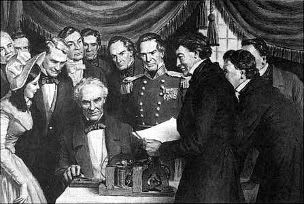
Morse
Demonstrates the Telegraph
|
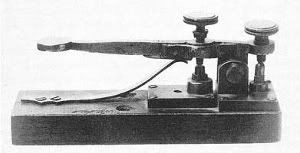
|
The
information in telegraphy is sent as a series of electrical signals.
Short signals are referred to as “dits,” (represented as dots), and
long signals are referred to as “dahs,” (represented as dashes). The
code relies on precise intervals of time between dits and dahs, between
letters, and between words. A dit is one unit of time, while a dah is
three units of time. The proper space between letters is 3 units, while
the space between words is 7.
Morse
code transmitting speed is measured in words per minute (or WPM). The
word “Paris” is used as the standard length of a word. If you
transmitted the word “Paris” 5 times (which requires 50 units of time),
you’d be transmitting at 5 words per minute.
|
MORSE
CODE & RADIO
|
Guglielmo
Marconi
|
In
the early 1890's, the Italian inventor, Guglielmo Marconi began
experimenting with wireless transmissions of morse code, gradually
increasing the range of his transmissions from being measured in mere
meters to distances of several hundred kilometers. Although Marconi was
not the only one experimenting with radio, (Nikola Tesla was another),
he was able to improve the technology to a point where it became useful
both commercially and militarily. In the early 20th century, the first
practical applications for radio telegraphy was with maritime
communications. It was seen as a replacement for the centuries-old
practice of signaling by flags, lights, and foghorns.
Marconi's
greatest achievement came on December 12, 1901, when he received a
message sent from England at St. John's, Newfoundland. It was the first
Trans-Atlantic radio contact.
|
| Thomas
White, in his article, “United States Early Radio History,” stated that
the new technology, “greatly reduced the terrible isolation of ships
during emergencies, and was quickly responsible for saving thousands of
lives." Shortly after the Titanic disaster in 1912, the International
Convention for the Safety of Life at Sea convened, and produced a
treaty in 1913, requiring shipboard radio stations to be manned 24
hours a day. Stations at the time consisted of spark-gap transmitters,
which used a rotating commutator with 6-12 contacts per wheel, driven
by about 2000 volts DC. As the gap made and broke contact, the radio
wave was audible in a magnetic detector at the receiving station. These
were eventually replaced by continuous wave transmitters (inspiring the
short-hand name CW for wireless telegraphy). |

HMS
Titanic
|
ADVANTAGES
Morse
Code is one of the simplest modes that can be used to make radio
communications over long distances, and it doesn’t require complicated
transmitting or receiving equipment to get on the air. Some
of the advantages of CW are it’s ability to override noise and static
and still make itself readable, along with it’s ability to occupy only
a fraction
of the bandwidth of radio telephony signals, and it’s universal nature.
A
Universal
Language
John
Desmond writes in his article, “The Advantages of CW,” that, “no matter
who you are talking to in the world, you can complete a contact on CW.”
That’s because there’s a series of internationally recognized Q-signals
and short-hand terms that are understood by any ham radio operator in
the world. When you give a signal report of “five and nine” using
phone, the receiving party’s ability to understand English will
determine whether or not the message gets across, but using CW, a
report of 5 9 9 always means the same thing.
Bandwidth
Another
advantage of CW is the fact that a QSO can take place in a bandwidth of
about 300 Hz, compared to 2.5 KHz for SSB, and up to 10 KHz for FM.
This means you can fit a lot more QSO’s into a given bandwidth, which
is especially important on some of the HF bands, where there is
sometimes very small portions allocated for CW. In addition, because
you are tuning in a signal on a narrow piece of the band, it makes it a
lot easier to filter out interference.
Simple
and
Effective
Although
ham radio equipment has become extremely advanced over the years, there
isn’t much required to make contacts using CW. All you have to do is to
generate a carrier and turn it on and off. Because of its cost
effectiveness, you’ll hear stations on CW that you’ll most likely never
hear on any other mode.
CW
equipment can be easily built by most prospective hams. In fact, an
entire group of Amateur Radio enthusiasts specialize in building and
using very simple, low powered stations (known as QRP, in ham radio
parlance). There are thousands of QRP enthusiasts around the world,
who, for only a few tens of dollars, construct and operate their entire
station, including antenna, transmitter and accessories.
Efficiency
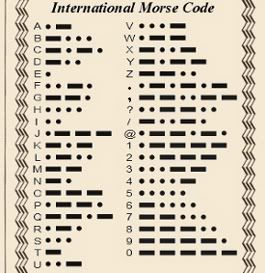 |
Morse
code remains the simplest and most efficient way known to send messages
via radio. Messages can be sent with less transmitter power than by any
other method (except for ultra-complicated "spread spectum" systems,
which are expensive, difficult to construct, and beyond the reach of
the average ham). Morse code signals will also penetrate interference,
both natural and man-made, better than most complex modes. In fact,
when band conditions are poor, CW is often the only way to make DX
contacts.
Another
aspect of its efficiency, is CW’s ability to be copied through high
levels of noise. John Desmond uses the example of a SSB signal being
“lost” when fading takes hold of the band, saying: “On SSB, once the
signal goes beyond a certain point, then that’s it, you have no idea
what the other station is saying. On CW, it really is amazing how far
into the noise a signal can go and you can still copy it.”
|
|
TOOLS
OF THE TRADE
Straight
Key
A
straight key was the first type of telegraphy key used, and it has
stayed true to its original design for more than 150 years.
The
key is made up of a hinged bar with a knob on top and a contact
underneath. When the bar is depressed against spring tension, it
completes a circuit, thus allowing the operator to send a
message. In the late 1840's, straight keys were
used by
railway systems, internal government agencies, and for public
communications. The key is simple and reliable, but transmission speeds
are limited to around 20 words per minute.
Bug
(Semi-Automatic)
Around
the turn of the 20th Century, as Morse sending speeds increased, many
operators wanted a faster sending key. Transmission speeds were limited
on a straight key, and repetitive stress injuries such as
“Telegrapher’s Paralysis,” or “Glass Arm,” was common among those who
sent high speed code on straight keys for long periods of time. The
answer was the “bug,” which used a vibrating steel arm to automate the
sending of dots. The bug, or semi-automatic key, is operated by the
side-to side motion of a lever, that if pressed to the left creates a
“dah,” or dash, and if pressed to the right, activates a vibrating arm
to create “dits.” The “bug” was first popularized by the Vibroplex
company and is often called a Vibroplex, regardless of the
manufacturer. Several companies created their own designs, including
Lionel, Dow, (which made a rotatable bug), Speed-Ex, McElroy, and
others. The bug allows a skilled operator to send at speeds of up to 40
words per minute.
Sideswiper
(Cootie Key)
The
Sideswiper, or “Cootie Key,” is another
alternative to the straight key. The Sideswiper was the first to use a
side-to-side motion, and its action is considered faster than that of a
straight key. More than anything, it made sending code more
comfortable. The
design is basically that of a SPDT switch with a return-to-neutral
feature that assures your carrier doesn’t remain on the
air
between dots and dashes. According to John Myers, in his article Modernization
of an Old Favorite,
what “sets aglow the warm feeling
many of us have for the sideswiper is that it gives character to one’s
fist. Such character isn’t achievable with modern keyers by any but the
most dogged - and it’s impossible with a keyboard” (Myers).
There
is a mechanical limitation, though, to sending high speed code. This
was
answered by electronic keyers, which make use of electronic circuits to
automatically generate dots and dashes.
Iambic
Paddle
An
iambic paddle
uses electronics to create exact separation between dashes and dots.
Because of this, a paddle, electronic keyer, (which translates the
paddle’s movements into Morse code), and a transmitter are required.
Most modern HF rigs have built-in keyers, so a separate one is not
required. Although paddles come in either a single lever or dual lever
variety, the dual lever paddles are most common. Paddles have two
separate movements and sets of contacts, and are operated with a gentle
side to side motion. Because there’s no mechanical vibration to create
the “dits,” it doesn’t require much force to used one. Chuck Adams
writes in is article, Using
an Iambic Paddle, that “Just a light touch
is all it takes if you have it adjusted correctly. If the paddle moves
around on the table while you’re sending then you are using too much
force,” and finishes the by saying, “Take it easy. It isn’t going
anywhere on its own.” One of the benefits of the iambic paddle is its
ease of operation, which along with the exact spacing allowed by the
electronic keyer, increases operating speed tremendously
(Adams).
Some
popular iambic paddles include the N2DAN Mercury (now
manufactured by Bencher), Bencher’s BY-1, (USA) M0AGA's Chevron
(England), and paddles produced by UR5CDX (Ukraine) and Begalli (Italy).
Between
1940 and the mid 1960's, electronic keyers made steady progress. In
1940, W2ILE created an electronic bug, which used a thyratron to
generate automatic dots and dashes. Later came a tube-based design by
Jim Ricks, W9TO, which allowed code to be sent by paddles up to 65
words per minute. Several solid state designs followed, but CW
operators could not reliably send accurate code at speeds above 50
words per minute. The next step was a departure in traditional
telegraphy - the keyboard.
CW
Keyboard
As
the
name infers, sending by
this
method is done by “typing” on and actual keyboard that is connected to
a stand-alone “box” or computer. The self contained units include the
keyboard and the electronics needed to generate the code elements. Many
just plug into the key jack of you transmitter. MFJ manufactures a
keyboard keyer interface that goes between a keyboard and a
transceiver, and there are also software programs such as FL Digi, and
CW Type, which puts your PC between the keyboard and the rig. Many high
speed CW enthusiasts enjoy operating “QRQ” using their keyboards to
transmit from 60 to over 100 words per minute (Gerry).
|
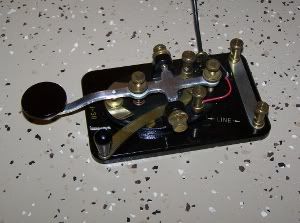
Lionel J-38 (1942)
Straight Key
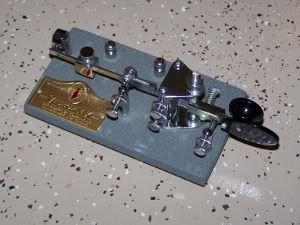
Vibroplex "Champion"
(1962) Bug
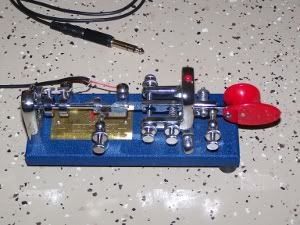
Vibroplex "Blue Racer" (2000)
Bug
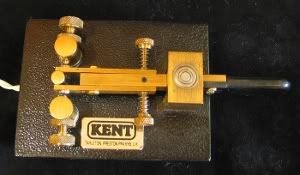
Kent Single Lever (1998) Cootie
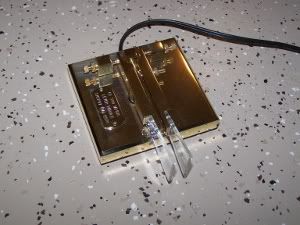
UR5CDX "CT 599" (2010) Iambic
Paddle
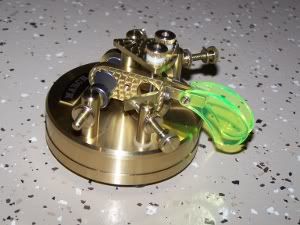
March "R3A" (2010) Magnetic
Paddle
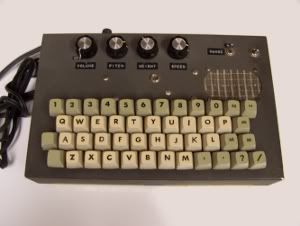
K4KN Morse Keyboard (1974)
|
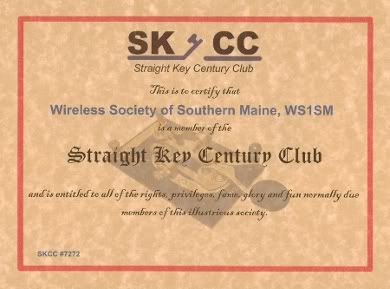
SKCC #
7272 |
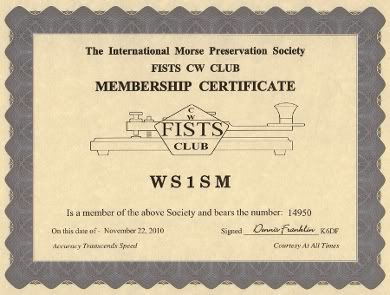
FISTS
# 14950 |
CW
OPERATING GROUPS
CW
LINKS
Smartphone
APPS
Works Cited
Adams,
Chuck. "Using an Iambic Keyer."
5 December 2010. http://www.k7qo.net/sending.pdf
Desmond, John. "The Advantages of CW." 5 December 2010.
http://www.qsl.net/ei7gl/cwadvant.htm
Gerry, Joe. "QRQ (High Speed) CW." CQ
Amateur Radio. Vol. 66. No. 9. September 2010.
Myers, John. "Modernization of An Old Favorite." 4 December 2010.
http://www.sideswipernet.org/articles/w9ok-modernization.php
White, Thomas. "U.S. Early Radio History." 4 December 2010.
http://earlyradiohistory.us
Horne, Thomas. "History of the Vail Lever Correspondent." 26
February 2018. http://www.ws1sm.com/Vail-Lever-Correspondent-Key.html |
|